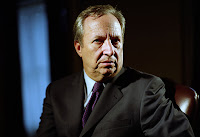Just for the heck of it, I checked Wikipedia on Barton Biggs and found he was chief global strategist for Morgan Stanley for 30 years before partnering at Traxis. Institutional Investor rated him the "top global investor" from 1996 to 2000 and he's been "the premier prognisticator on the global scene" according to Smart Money mag.Speaking exclusively with The Wall Street Journal, Barton Biggs, managing partner at multibillion dollar hedge fund Traxis Partners, painted a bleak outlook for the developed world with only huge government intervention likely to improve things...
Barton Biggs, re-born in Keynesia
Mr. Biggs, former chief global strategist for U.S. investment banking powerhouse Morgan Stanley, demanded the U.S. government temporarily return to ideas used in the Great Depression as a way to get the country back to higher growth.
“What the U.S. really needs is a massive infrastructure program … similar to the WPA back in the 1930s,” he says.
The plan would be to employ some of the many unemployed people, jump start the economy, as well as help catch up with Asia, which is building state-of-the-art infrastructure from new mechanized port facilities to high-speed trains.
He suggested financing such building through the sale of U.S. Treasuries.
So Biggs is a formidable, greatly respected character in the upper echelons of global finance. And he's currently pushing hard-core "New Deal" style Keynesianism in response to the economic crisis that puts him approximately in Bernie Sanders' territory.
Welcome aboard, Mr. Biggs. Now, not to be rude, but what about those bizarre super-low tax rates on your mega-compensation as a hedge fund manager?


